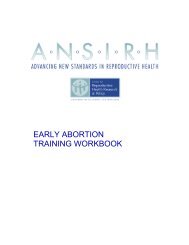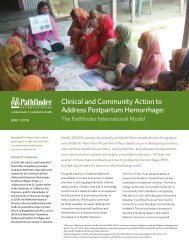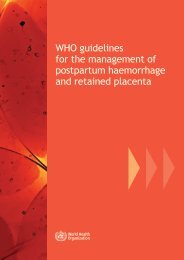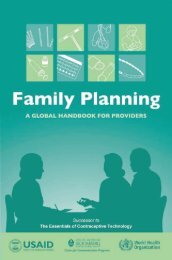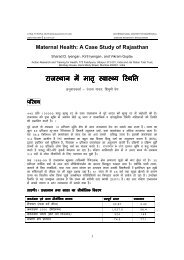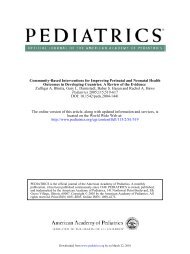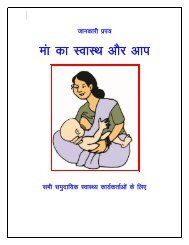Gender Gaps in Research on Abortion in India - CommonHealth
Gender Gaps in Research on Abortion in India - CommonHealth
Gender Gaps in Research on Abortion in India - CommonHealth
You also want an ePaper? Increase the reach of your titles
YUMPU automatically turns print PDFs into web optimized ePapers that Google loves.
midwife, and six from n<strong>on</strong>-allopathic doctors.<br />
C<strong>on</strong>cern for secrecy may override that for safety. Women <str<strong>on</strong>g>in</str<strong>on</strong>g> rural West Bengal who had suffered<br />
complicati<strong>on</strong>s follow<str<strong>on</strong>g>in</str<strong>on</strong>g>g an unsafe aborti<strong>on</strong> stated that they had g<strong>on</strong>e to untra<str<strong>on</strong>g>in</str<strong>on</strong>g>ed providers <str<strong>on</strong>g>in</str<strong>on</strong>g> order to<br />
ma<str<strong>on</strong>g>in</str<strong>on</strong>g>ta<str<strong>on</strong>g>in</str<strong>on</strong>g> the secrecy and an<strong>on</strong>ymity (76).<br />
What are women's reas<strong>on</strong>s for choice of a particular aborti<strong>on</strong> provider? In Maharashtra (10), the ma<str<strong>on</strong>g>in</str<strong>on</strong>g><br />
reas<strong>on</strong>s were that the provider was a specialist, stated by 81% of the women, followed by 61% who<br />
chose a provider because s/he was 'good-natured, listens and expla<str<strong>on</strong>g>in</str<strong>on</strong>g>s'. Similar reas<strong>on</strong>s were cited by<br />
aborti<strong>on</strong> users <str<strong>on</strong>g>in</str<strong>on</strong>g> Varanasi (55), but cost was the most important c<strong>on</strong>siderati<strong>on</strong> above all else. Those<br />
who could afford went to a private cl<str<strong>on</strong>g>in</str<strong>on</strong>g>ic such as the Parivar Seva Sanstha, and those who did not have<br />
the m<strong>on</strong>ey went to the traditi<strong>on</strong>al dai who used unsafe methods and charged a low fee. In Chandigarh<br />
(70), the choice was based <strong>on</strong> recommendati<strong>on</strong>s by a physician or the local auxiliary nurse midwife<br />
(ANM) <str<strong>on</strong>g>in</str<strong>on</strong>g> about a third of the women, and the quality of care and cost were each stated as a reas<strong>on</strong> <strong>on</strong>ly<br />
by 12.5%. Am<strong>on</strong>g adolescents seek<str<strong>on</strong>g>in</str<strong>on</strong>g>g aborti<strong>on</strong> <str<strong>on</strong>g>in</str<strong>on</strong>g> Haryana, 86% identified cost and c<strong>on</strong>fidentiality as<br />
the most important factors govern<str<strong>on</strong>g>in</str<strong>on</strong>g>g choice of aborti<strong>on</strong> provider (50).<br />
<str<strong>on</strong>g>Research</str<strong>on</strong>g> gaps<br />
Draw<str<strong>on</strong>g>in</str<strong>on</strong>g>g <strong>on</strong> the 'three delays' model <str<strong>on</strong>g>in</str<strong>on</strong>g> seek<str<strong>on</strong>g>in</str<strong>on</strong>g>g obstetric care, there appear to be four major<br />
delays <str<strong>on</strong>g>in</str<strong>on</strong>g> term<str<strong>on</strong>g>in</str<strong>on</strong>g>at<str<strong>on</strong>g>in</str<strong>on</strong>g>g an unwanted pregnancy successfully. The first delay occurs <str<strong>on</strong>g>in</str<strong>on</strong>g> recognis<str<strong>on</strong>g>in</str<strong>on</strong>g>g the<br />
symptoms of pregnancy; the sec<strong>on</strong>d, <str<strong>on</strong>g>in</str<strong>on</strong>g> decid<str<strong>on</strong>g>in</str<strong>on</strong>g>g to term<str<strong>on</strong>g>in</str<strong>on</strong>g>ate the pregnancy; the third, <str<strong>on</strong>g>in</str<strong>on</strong>g> mak<str<strong>on</strong>g>in</str<strong>on</strong>g>g c<strong>on</strong>tact<br />
with an aborti<strong>on</strong> provider; and the fourth, <str<strong>on</strong>g>in</str<strong>on</strong>g> hav<str<strong>on</strong>g>in</str<strong>on</strong>g>g the pregnancy term<str<strong>on</strong>g>in</str<strong>on</strong>g>ated successfully. As seen<br />
above, <str<strong>on</strong>g>in</str<strong>on</strong>g>formati<strong>on</strong> <strong>on</strong> <strong>on</strong>e or the other delay is available from many studies. However, there is no<br />
s<str<strong>on</strong>g>in</str<strong>on</strong>g>gle study that traces the pathway to <str<strong>on</strong>g>in</str<strong>on</strong>g>duced aborti<strong>on</strong> <str<strong>on</strong>g>in</str<strong>on</strong>g> a large enough group of women of<br />
vary<str<strong>on</strong>g>in</str<strong>on</strong>g>g characteristics.<br />
We also do not know how each delay is <str<strong>on</strong>g>in</str<strong>on</strong>g>fluenced by gender-factors such as lack of awareness of <strong>on</strong>e<br />
's body, shame and embarrassment related to an unwanted pregnancy, lack of decisi<strong>on</strong>-mak<str<strong>on</strong>g>in</str<strong>on</strong>g>g power,<br />
the need to f<str<strong>on</strong>g>in</str<strong>on</strong>g>d an escort or the m<strong>on</strong>ey to go to an aborti<strong>on</strong> facility, fear or be<str<strong>on</strong>g>in</str<strong>on</strong>g>g reprimanded<br />
by the provider, and be<str<strong>on</strong>g>in</str<strong>on</strong>g>g passed <strong>on</strong> from <strong>on</strong>e provider to another because of provider-percepti<strong>on</strong>s <strong>on</strong><br />
appropriate female sexual and reproductive behaviour. The comb<str<strong>on</strong>g>in</str<strong>on</strong>g>ati<strong>on</strong> of poverty and gender<br />
factors may exacerbate each delay for low-<str<strong>on</strong>g>in</str<strong>on</strong>g>come women. Cost of aborti<strong>on</strong> services as a reas<strong>on</strong> for<br />
delay <str<strong>on</strong>g>in</str<strong>on</strong>g> seek<str<strong>on</strong>g>in</str<strong>on</strong>g>g <str<strong>on</strong>g>in</str<strong>on</strong>g>duced aborti<strong>on</strong> has not been explored adequately <str<strong>on</strong>g>in</str<strong>on</strong>g> studies exam<str<strong>on</strong>g>in</str<strong>on</strong>g><str<strong>on</strong>g>in</str<strong>on</strong>g>g delay<br />
<str<strong>on</strong>g>in</str<strong>on</strong>g> care-seek<str<strong>on</strong>g>in</str<strong>on</strong>g>g.<br />
Studies show that women prefer to use private rather than public sector health facilities for hav<str<strong>on</strong>g>in</str<strong>on</strong>g>g an<br />
<str<strong>on</strong>g>in</str<strong>on</strong>g>duced aborti<strong>on</strong>. The attitude of pers<strong>on</strong>nel <str<strong>on</strong>g>in</str<strong>on</strong>g> public sector health facilities is menti<strong>on</strong>ed as a reas<strong>on</strong> <str<strong>on</strong>g>in</str<strong>on</strong>g><br />
some of the studies. A prospective comparis<strong>on</strong> of women's aborti<strong>on</strong> experiences <str<strong>on</strong>g>in</str<strong>on</strong>g> public and private<br />
sector health facilities may yield better <str<strong>on</strong>g>in</str<strong>on</strong>g>sights <str<strong>on</strong>g>in</str<strong>on</strong>g>to the range of reas<strong>on</strong>s for preferr<str<strong>on</strong>g>in</str<strong>on</strong>g>g <strong>on</strong>e over the<br />
other, and also the differences <str<strong>on</strong>g>in</str<strong>on</strong>g> profile of the women who use aborti<strong>on</strong> services <str<strong>on</strong>g>in</str<strong>on</strong>g> the public and<br />
private sector, and those who use the services of traditi<strong>on</strong>al providers.<br />
Aborti<strong>on</strong> and c<strong>on</strong>traceptive use 12<br />
Data <strong>on</strong> knowledge of reversible and permanent methods of c<strong>on</strong>tracepti<strong>on</strong> <str<strong>on</strong>g>in</str<strong>on</strong>g> <strong>India</strong> show high<br />
levels of knowledge of both, although sterilisati<strong>on</strong> is by far the best-known method to all groups of<br />
women. Also, use of sterilisati<strong>on</strong> has risen c<strong>on</strong>sistently over the past few decades and fertility<br />
levels have decl<str<strong>on</strong>g>in</str<strong>on</strong>g>ed <str<strong>on</strong>g>in</str<strong>on</strong>g> all states of <strong>India</strong>, more rapidly <str<strong>on</strong>g>in</str<strong>on</strong>g> some than <str<strong>on</strong>g>in</str<strong>on</strong>g> others. Despite the clear<br />
motivati<strong>on</strong> to regulate fertility, <strong>India</strong>n women often do not use c<strong>on</strong>tracepti<strong>on</strong>, especially for<br />
12. The follow<str<strong>on</strong>g>in</str<strong>on</strong>g>g studies fall under this secti<strong>on</strong>: Reference numbers 3, 10, 63, 70, 71, 72<br />
13



